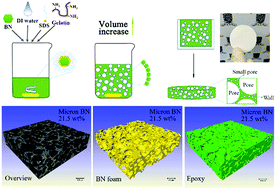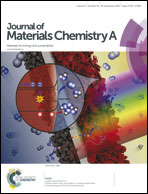A thermal interface material based on foam-templated three-dimensional hierarchical porous boron nitride†
Abstract
Developing thermal interface materials with high thermal conductivity and appropriate mechanical properties is of great significance for reliable operation and enhancing the lifetime of electronic devices. In this work, we developed a direct foaming method to fabricate a three dimensionally interconnected hierarchical porous boron nitride (BN)/epoxy composite for thermal interface material applications. The foam-templated approach allows for construction of an isotropic porous structure with low loading of fillers and is a versatile method that can be applied to various high-thermal conductivity fillers. Based on this method, we performed a comparative study on micron-size and submicron-size BN based thermal interface materials through combining structural, morphological and thermal property characterizations as well as defect analysis. The results demonstrate that, as compared to the submicron BN fillers, the micron BN fillers can form a better aligned distribution along the three dimensional network while introducing less defects and grain boundaries, resulting in high thermal conductivity both in-plane (5.19 W m−1 K−1) and out-of-plane (3.48 W m−1 K−1) at a low filler concentration of 24.4 wt%. This study provides guidelines on the design, fabrication and optimization of composite-based thermal interface materials.



 Please wait while we load your content...
Please wait while we load your content...